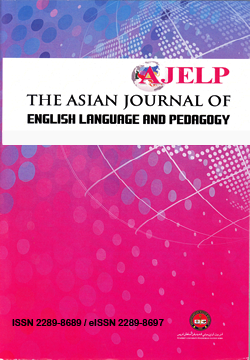The Role of Technology in Enhancing Intercultural and Pragmatic Competencies in EFL Class
DOI:
https://doi.org/10.37134/ajelp.vol11.2.6.2023Keywords:
Cultural competence, Pragmatic competence, Bi-directional approach, Digital tools, EFL ContextAbstract
There is a close relationship between language and culture, and a review of the literature indicates less attention is given to the enrichment of cross-cultural and pragmatic awareness in the classrooms. The role of culture in language learning is often overlooked in language classes. The notion of cultural competencies is often derived from English-speaking countries, and though students can learn from such a perspective, it does not provide a good model for developing their cultural and pragmatic competencies. Using students’ own cultural experiences would be a good way to enhance their cultural and pragmatic competencies. This investigation involves a qualitative approach, and the participants involved 10 EFL lecturers and 20 EFL students from China. Data was collected by using in-depth interviews, classroom observations, and field notes. The role of technology in enhancing these skills is highlighted in this study. The results indicated that the bidirectional approach of integrated language and cultural elements enhanced their pragmatic competence. The use of technology further promoted learner autonomy and independent learning. The study highlights the limitations of the unidirectional approach in language teaching and advocates a bidirectional approach to enhance pragmatic and cultural competencies, which can be ideal for EFL settings.
Downloads
References
Afshar, H. S., & Asakereh, A. (2016). Speaking skills problems encountered by Iranian EFL freshmen and seniors from their own and their english instructors' perspectives. Electronic Journal of Foreign Language Teaching, 13(1), 112–130.
Alemi, M., Maleknia, Z., & Meschi Nezami, B. (2023). Iranian EFL learners’ production of online English requests: effects of technology- mediated task-based instruction. Journal of Business, Communication & Technology, 2(1), 26-39.
Asrial, A., Syahrial, S., Kurniawan, D. A., Subandiyo, M., & Amalina, N. (2019). Exploring obstacles in language learning among prospective primary school teacher. International Journal of Evaluation and Research in Education, 8(2), 249-254.
Azad, M., Alipour, M., & Talebi, P. (2018). The effect of using networks on developing EFL learners’ pragmatic competence through speaking accuracy and fluency. Language Education Studies, 4 (4), 15-24.
Bachman, L. F. (1990). Fundamental considerations in language testing. Oxford University Press.
Banjongjit, B., & Boonmoh, A. (2018). Teachers’ perceptions towards promoting intercultural communicative competence in the EFL classroom. REFLections, 25(2), 76-97.
Bardovi-Harlig, K. (2017). Acquisition of L2 pragmatics. The Routledge handbook of instructed second language acquisition, 224-245.
Byram, M. (2020). Teaching and assessing intercultural communicative competence: Revisited. Multilingual Matters.
Council of Europe. (2018). Common European framework of reference for languages: Learning, teaching, assessment companion volume with new descriptors. Strasbourg: Council of Europe. Retrieved from https://www.coe.int/lang-cefr
Charmaz, K. (2006). Constructing grounded theory: A practical guide through quantitative analysis. SAGE.
Chen, J. J., & Yang, S. C. (2014). Fostering foreign language learning through technology enhanced intercultural projects. Language Learning & Technology, 18(1), 55-75.
Doughty, C. (2001). Cognitive underpinnings of focus on form. In P. Robinson (Ed.), Cognition and second language instruction (pp. 206-257). Cambridge University Press.
Eslami, Z. R., Mirzaei, A., & Dini, S. (2015). The role of asynchronous computer mediated communication in the instruction and development of EFL learners' pragmatic competence. System, 48, 99-111.
Galla, C. K. (2016). Indigenous language revitalization, promotion, and education: Function of digital technology. Computer Assisted Language Learning, 29(7), 1137-1151.
Gholamia, J., & Aghaib, H. K. (2012). The impact of explicit and implicit instruction on Iranian EFL learners' production and recognition of language function. International Journal of Physical and Social Sciences, 2(9), 107-131. http://dx.doi.org//10.1.1.415.9206
Glaser, K. (2018). Enhancing the role of pragmatics in primary English teacher training. Glottodidactica. An International Journal of Applied Linguistics, 45(2), 119-131.
Hussein, N. O., & Albakri, I. S. M. A. (2019). The essential role of teaching pragmatics in the Iraqi EFL classroom. practice, 10(4).
Jata, E. (2015). Perception of lecturer on intercultural competence and culture teaching time (Case Study). European Journal of Interdisciplinary Studies, 3(1), 197-201.
Juan-Garau, M., & Jacob, K. (2015). Developing English learners' transcultural skills through content and task-based lessons. System, 54, 55-68.
Kamiya, M. (2006). The role of communicative competence in L2 learning. Sophia Junior College Faculty Bulletin, 26, 63-87.
Kramsch, C. (1995). The cultural component of language teaching. Language, Culture and Curriculum, 8(2), 83–92.
Levitt, H. M., Bamberg, M., Creswell, J. W., Frost, D. M., Josselson, R., & Suárez-Orozco, C. (2018). Journal article reporting standards for qualitative primary, qualitative meta-analytic, and mixed methods research in psychology: The APA Publications and Communications Board task force report. American Psychologist, 73(1), 26.
Patton. M. Q. (2002). Qualitative research and evaluation methods (3rd ed.). Thousand Oaks, CA: Sage Publications.
Sevy-Biloon, J., & Chroman, T. (2019). Authentic use of technology to improve EFL communication and motivation through international language exchange video chat. Teaching English with Technology, 19(2), 44-58.
Sherman, R. R., & Webb, R. B. (Eds.). (1988). Qualitative education research: Focus and methods (Vol. 3). Psychology Press.
Taguchi, N., & Kim, Y. (2014). Collaborative dialogue in learning pragmatics: Pragmaticrelated episodes as an opportunity for learning request-making. Applied Linguistics, 37(3), 416–437. https://doi.org/10.1093/applin/amu039
Tajeddin, Z., Alemi, M., & Pashmforoosh, R., Tran, T. Q., & Duong, T. M. (2018). The effectiveness of the intercultural language communicative teaching model for EFL learners. Asian-Pacific Journal of Second and Foreign Language Education, 3, 1-17.
Vasquez, C., & Sharpless, D. (2009). The role of pragmatics in the master's TESOL curriculum: Findings from a nationwide survey. TESOL Quarterly, 43(1), 5-28. https://doi.org/10.1002/ j.1545-7249.2009.tb00225.x
Xiuwen, Z., & Razali, A. B. (2021). An overview of the utilization of TikTok to improve oral English communication competence among EFL undergraduate students. Universal Journal of Educational Research, 9(7), 1439-1451.
Downloads
Published
Issue
Section
License
Copyright (c) 2023 Latha Ravindran, Mansour Amini

This work is licensed under a Creative Commons Attribution-NonCommercial-ShareAlike 4.0 International License.





